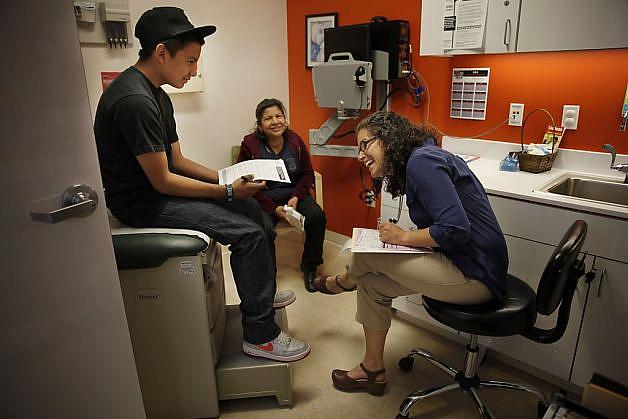Bring public health issues to life by finding the right people to share their stories

Karen Gersten-Rothenberg, director of Havenscourt Health Center, talks with Carlos Aguilar and his mother. (Lea Suzuki/The Chronicle)
Ever since I started on the health beat, I've been interested in socioeconomic and environmental determinants of health in underserved communities. For my fellowship project, I explored this subject in three distinct feature stories.
The first was about an Affordable Care Act grant that is pouring millions of dollars into chronic disease prevention strategies in rural communities across the nation. I profiled one recipient, Mendocino County, a couple hours north of San Francisco. In the second story, I wrote about a long-running UC Berkeley study of environmental exposures and their effects on Mexican-American farmworkers in the Salinas Valley. And in the third story, I described how Alameda County health providers became inspired by a visit to Cuba to expand a network of community clinics that served low-income patients.
While each subject was unique, all three required me to read studies, find and understand data about health outcomes, interview experts and spend hours outside the office.
But probably the toughest challenge I faced was finding real, flesh-and-blood people in each community I explored.
I had no problem finding data, reports and experts that could tell me about residents' poverty rates and life expectancies from a bird's-eye view. It was much harder, however, to find people who not only wanted to tell me about their struggles with health care, but also gave their full names, trusted me, answered their phones and agreed to be photographed. It goes without saying that their voices are among the most important ones to include in stories. Without them, all we have are numbers and talking heads.
It took a while, but in the end, I found some terrific, interesting people who generously opened up to me.
What helped tremendously, first of all, was that I had the cooperation of the leaders overseeing the programs I was writing about. This was particularly useful in Mendocino and Salinas, where the residents and study participants were spread out all over their respective counties and didn't routinely congregate in one place. Health officials in Mendocino helped me find a housekeeper who shopped for groceries outside her county because she felt like she couldn't afford the healthy food sold in town. The UC Berkeley researchers helped connect me with a handful of fieldworkers who were willing to share their fears about pesticides.
But the folks in charge were busy with their own work, of course, so it took longer than expected for them to track down people. People, in turn, are busy with their own lives. The fieldworkers in the UC Berkeley study moved around depending on the time of year and what work was available to them in the fields. From the time I asked the researchers to recommend a participant or two, six months passed before I sat down with a smiling storeowner and former fieldworker. So, if you're looking for the right person, make sure to give yourself more time than you think you need. (And keep in mind: When people come recommended, they're probably not going to say anything too controversial or upsetting.)
Other times, you'll have to find the people yourself. For the Cuba/Alameda County project, I wanted to illustrate how this region's network of clinics provided holistic care and encouraged patients to be proactive about their health. So I spent several days chatting with students at one such clinic in a middle/high school. Every student under age 18 and his/her parent had to sign a media release form before he or she talked to me, as required by the clinic's directors. When you enter a new place, figure out the rules and expectations.
If possible, interview people in the language they're most comfortable in. I speak proficient Spanish, which really helped me connect with Hispanic, Spanish-speaking patients and their families. But I'm also not fluent, so when I needed to make sure I understood what was being said, I got creative. I recorded conversations and played them back later to check quotes. English-speaking sons and daughters of immigrants sometimes interpreted what Mom or Dad were saying. In Salinas, a UC Berkeley researcher stepped in to offer interpretation when I spoke with participants in her office. If you don't know the language and don't exactly have time to Rosetta Stone it, take the time before reporting trips to find an interpreter you trust.
Gaining trust is difficult, but I found transparency to be the best approach. In the clinic, I explained who I was and what I was doing. I also handed out a little sheet of paper that explained my project in English and Spanish. I asked if they had a few minutes to chat about why they were there. Did they come to this clinic often? What did they like about it?
If their body language was tense or their answers were terse, I would wrap up. But if it went well, we'd have a lively discussion about their health problems and all the other problems in their lives that made it hard to be healthy. At this point, I would give them my business card and get their cell phone number and other contact information.
This part was important because lots of people disappeared: voice mails never got returned, phones got disconnected. Cast a wide net, because you never know who you'll end up wanting to talk to again. Until you sit down to write, you don't know whose stories will work best on the page.
Finding real people can be one of the hardest parts of journalism, but it is also usually one of the most rewarding and moving. So don't give up. Keep reaching out, and eventually someone will reach back.
